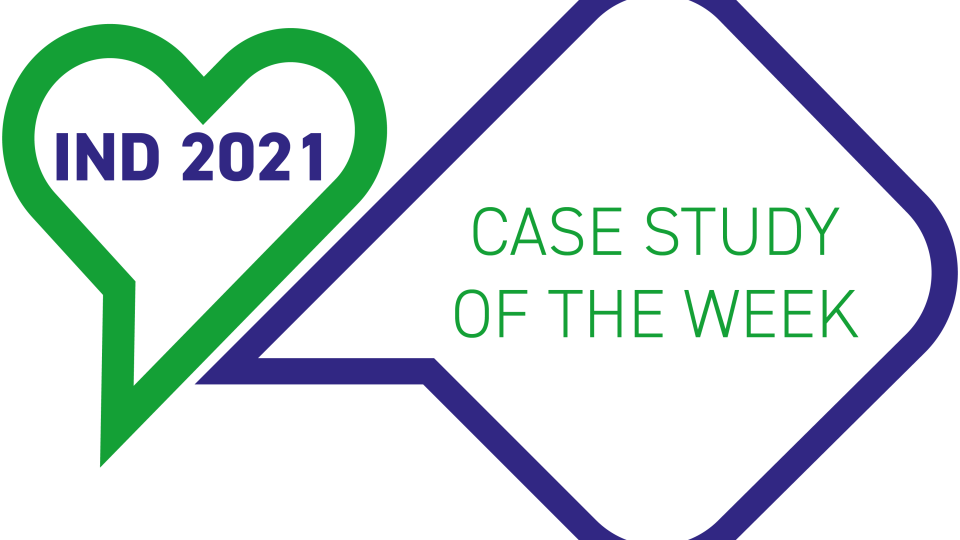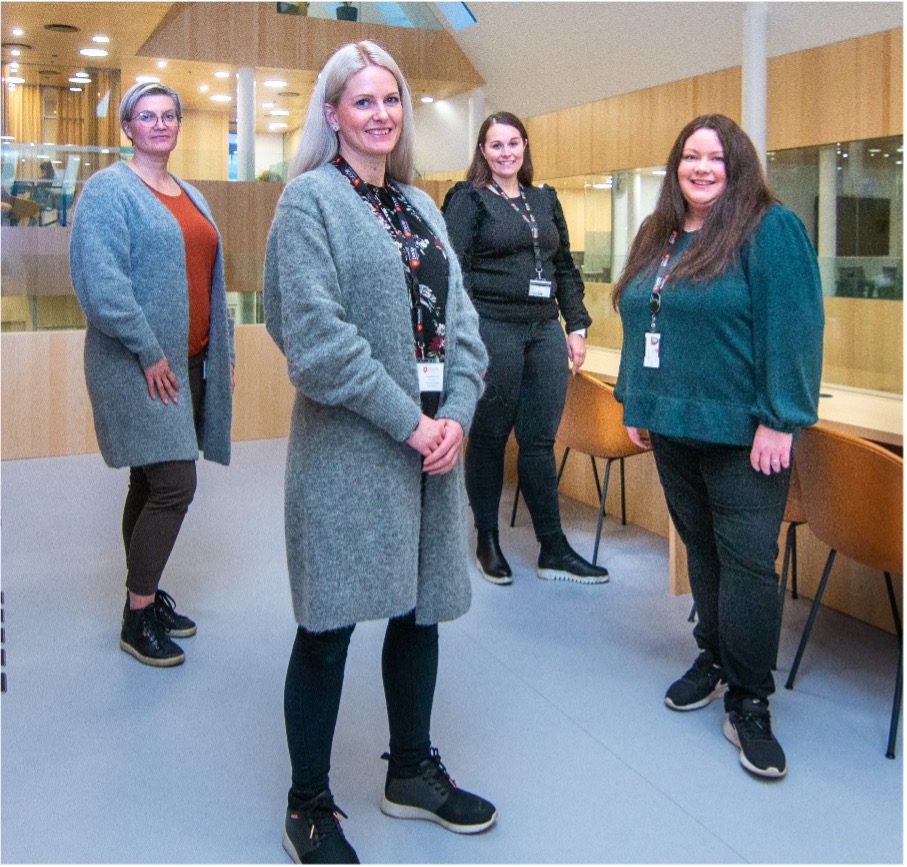Remote monitoring of COVID-19 patients, Norway


Photo 1: Nurses in the response centre. from left: Birgitte Cetin, Therese Hauge, Vibeke Tellmann and Mariell W. Borge
The COVID-19 pandemic has not afflicted the population of Bodø, Norway, that heavily. Up to and including the month of November 2020, there were just 150 confirmed cases (0.28% incidence) with no fatalities. However, the health and social services were not adequately prepared to tackle the challenges of the pandemic, while simultaneously continuing to provide regular health services. It was necessary to rethink how health services were provided and find innovative new solutions to maximise effectiveness of the limited resources available.
Like several other Norwegian municipalities, Bodø has a challenge regarding nursing resources. Shortage of nurses and other healthcare providers, limited access to personal protective equipment (PPE), and limited bed capacity at the municipal institutions were three crucial issues that needed addressing urgently.
Work overload and the potential of exposure and spread of infection among nurses and other healthcare providers were additional concerns. Nurses in quarantine or isolation due to infection posed a major threat to how health services are provided.
Early on, it became apparent that a system was needed to monitor patient compliance with regards to isolation rules, whilst at the same time providing for monitoring of patient’s health status, allowing early detection of deterioration, in particular silent hypoxia.
Bodø is one of six municipalities participating in an on-going national randomized controlled trial on remote monitoring of chronically ill patients. Patients are instructed how to measure and report their vital signs and health status via a smartphone or tablet to a response centre where data is collected and analysed daily. An appropriate response is then triggered based on the results. The goal of this project is to explore new and reliant alternatives for future healthcare services to provide a national recommendation on how healthcare services should be organised, operated and implemented. The project also aims to look at whether distance monitoring can lead to a more targeted use of nurses and their expertise.
Since Bodø municipality already had a solution for remote monitoring of patients and a response centre with trained nurses, it was determined that this remote monitoring system would be the quickest and most viable solution to address the additional challenges posed by the pandemic, especially since the necessary infrastructure was already in place.
A panel consisting of four physicians, an e-health consultant and nurses was setup to determine the criteria for patient eligibility. Two groups of COVID-19 patients were identified as best suited for remote monitoring: those placed in home isolation and those admitted to the isolation ward at the community hospital. Patients’ eligibility was based on their clinical condition and potential risk for rapid deterioration. In addition, a questionnaire on signs and symptoms (malaise, sore throat, cough, breathing difficulties, etc.) was developed to complement a list of vital signs (blood-oxygen saturation level, temperature, blood pressure, etc.) that were to be monitored. A predefined flowchart was created to aid both the patient and the nurses in the response centre to decide when a response was indicated and what type of medical action was warranted. The flowchart triaged the patients automatically based on their monitored data, which included both sensor based and self-reported data. The flowchart was kept simple to facilitate patient self-monitoring, partaking in the decision-making and managing of their own illness.
The proposed system consisted of three elements: an end-user reporting application, a web-based application for data accumulation and analysis, and finally a response centre staffed by trained nurses. All applications were developed in collaboration with the telecommunication company Telenor/Tellu. The simplicity of the design of the application design was essential to ensure patient compliance and data reliability. The application could be downloaded and installed on the patient’s own smartphone or on a tablet provided by the municipality. To comply with digital privacy and security regulations, the patients were required to log on to their profile using a secure electronic ID code (BankID). In addition, all participants were required to sign a consent form.
Patients were given the necessary equipment with instructions on how to measure their own vital signs. After installing the application, patients answered a survey regarding their medical history, relevant background information and current symptoms. Thereafter, the patients were instructed to report their symptoms and vital signs for daily assessment.
The application was also used to send relevant instructions and information to the patients, for example, how to correctly measure their vital signs, end of isolation duration, updates on quarantine rules, etc. The application also provided the information in different languages to accommodate other ethnicities and tourists.
All patients underwent a risk assessment for the potential of severe deterioration in their health condition due to COVID-19 infection. Patients were thus divided into two risk groups: low risk and medium-to-high risk. Based on this risk assessment, monitoring and follow-up were individualized. Patients with low risk were required to measure and report only their body temperature and answer a questionnaire regarding their signs and symptoms. Patients in the medium-to-high risk group were required to report on all of their vital signs and were provided with a wireless communication with the application which automatically transmitted the data to the system.
Data collection and analysis were performed remotely via a web-based application at a response centre. The nurses in the response centre, in collaboration with the patient’s general practitioner, had the medical responsibility for following-up and monitoring patients under home isolation. For patients admitted to the isolation ward, the responsibility was delegated to the on-duty nurse and ward physician. The nurses in the response centre could follow-up patients via either chat, video or telephone, and when necessary would contact emergency services.
The following goals were set for remote monitoring:
- Reduce exposure and thereby the risk of infection to healthcare personnel, which, in turn, would avoid spreading the disease to risk patient groups and to healthcare institutions
- Monitor a large group of patients simultaneously, with a limited nurse and other health care personnel resource
- Early identification of those at risk of deterioration and in need of immediate medical attention and/or hospitalization
- Provide safety and reassurance for patients placed under home isolation
- Cost-effective time spent by the nurses
- Create an effective communication portal between isolated patients and the municipality nurses
- Reduce the use of PPE to the minimum by preventing physical visits by nurses
A total of 68 patients were recruited between the months of March and November (58 in home isolation, 10 in the isolation ward group). Decreasing the frequency of direct contact with infected patients reduced the exposure risk of infection to the nurses. This in turn has contributed to keeping the pandemic at bay and out of the healthcare institutions, protecting the institutionalizsd high-risk patient population and keeping mortality rate at zero percent.
One of the major challenges during the pandemic is the lack of access to PPE. By reducing the frequency of direct contact with infectious patients, the daily amount of PPE used was lowered by approximately 60-100% in isolation wards at the community hospital, depending on the patient’s status and needs. This also had an indirect cost-effective benefit. Monitoring patients at home relieved the burden on hospital and institution beds, hence making them available for critically ill patients. No adverse effects were reported and no major issues regarding patient compliance were noted, with a 100% compliance to home isolation rules.
Despite the robustness and adaptability of this system, we were confronted with two challenges. A prerequisite was the patient’s ability to actively cooperate and partake in his/her own examination and health state assessment. Patients with cognitive impairment were therefore automatically excluded. Secondly, a group of patients did not feel comfortable using digital solutions and were therefore offered an alternative option. They were given the same sensors, but all follow-ups were instead performed over the phone with a nurse who plotted the data into the system.
With the future development in sensor technology, monitoring and reporting will become automated, thus bypassing the need for active participation from the patient’s side, and increasing the applications’ potential adaptation to other medical conditions and patient groups.
With remote monitoring, the municipality of Bodø managed to create a tool for efficient monitoring of COVID-19 patients. More patients were monitored with less nurse resources than with conventional medical monitoring. In addition, less PPE was used. With remote monitoring, we can detect and treat severe complications such as silent hypoxia at an earlier stage, thus lowering the mortality rate. In our opinion remote monitoring is a reliable, feasible and cost- effective tool.